American Goldfinch: The Golden Bird
Updated: Jun. 30, 2022
The American goldfinch is one of the last songbirds to breed each summer. Look for these bright, thistle-loving beauties in your backyard.
What Does an American Goldfinch Look Like?
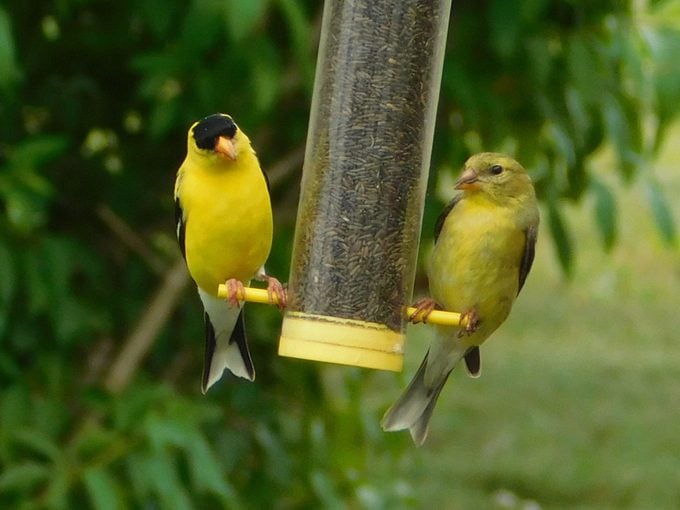
Female American Goldfinch
Females are less colorful year-round. The female American goldfinch is duller yellow with patches of drab olive and white wing bars. Meet the 3 types of goldfinches in the United States.
Winter American Goldfinch
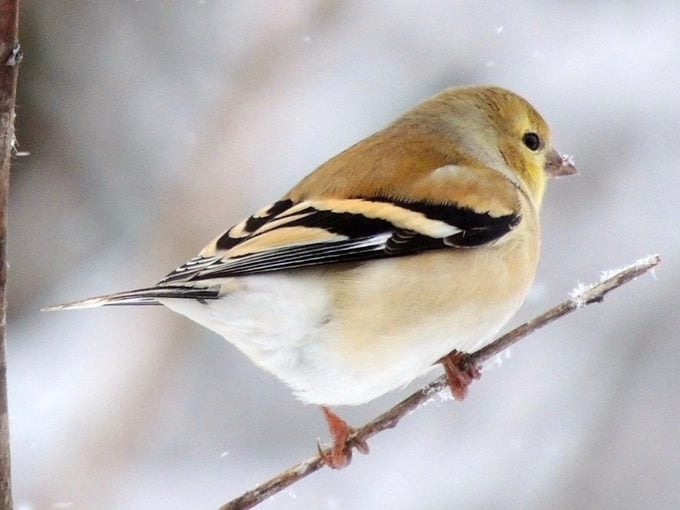
Male American goldfinches have one of the most noticeable molts. They change color twice a year, from dull brown to bright yellow and back again.
Birding experts Kenn and Kimberly Kaufman write, “Goldfinches, like most small birds, molt all their feathers at the end of summer or during fall. By the time winter arrives, the snappy yellow and black plumage of the males is replaced by a new, but much more drab, set of feathers, lacking the black cap and most of the gold tones. This molt during the fall is far less noticeable than the transition back to their bright breeding plumage in spring. It’s fascinating to watch how quickly the males transition back into their dapper summer plumage.” Psst—the lesser goldfinch is no less amazing.
American Goldfinch Nest and Eggs
The American goldfinch is one of the last songbirds to breed each summer. After couples pair up and select a nest site in a bush or shrub—not too high off the ground—females build an open cup nest. It’s woven with plant fibers and rootlets. The foundation is supported by spider silk, and the inside is lined with fluffy material taken from seed heads, thistle or milkweed down.
By the time they have young in the nest in late summer, American goldfinches can easily find an abundance of wild seeds to feed their offspring. The female goldfinch lays four to six pale-blue eggs.
A female typically selects one partner, though afterward she sometimes mates with another male.
Don’t miss 20 pretty pictures of finches.
Baby American Goldfinch
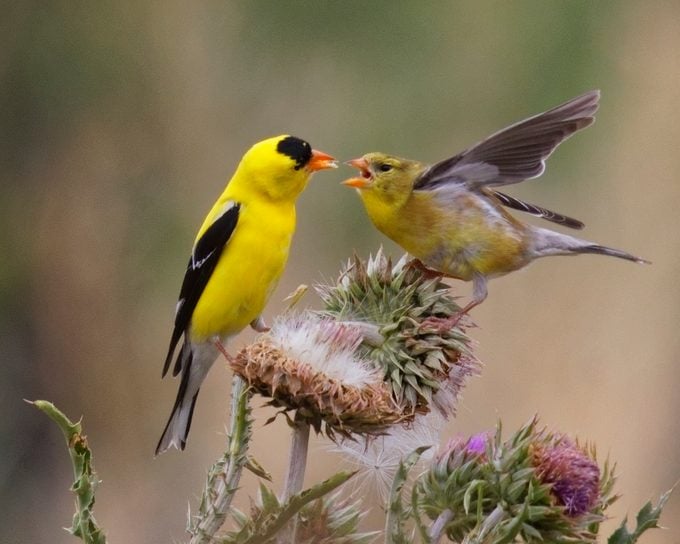
Most fledglings leave the nest 11 to 17 days after hatching, so by late summer you may see olive-colored youngsters at your feeders. Even the young birds are strictly vegetarian. Most baby songbirds are fed primarily bugs, but goldfinch parents give their chicks seeds from milkweed, thistle and other plants.
Pine siskin vs goldfinch: Here’s how to tell the difference.
What Do American Goldfinches Eat?
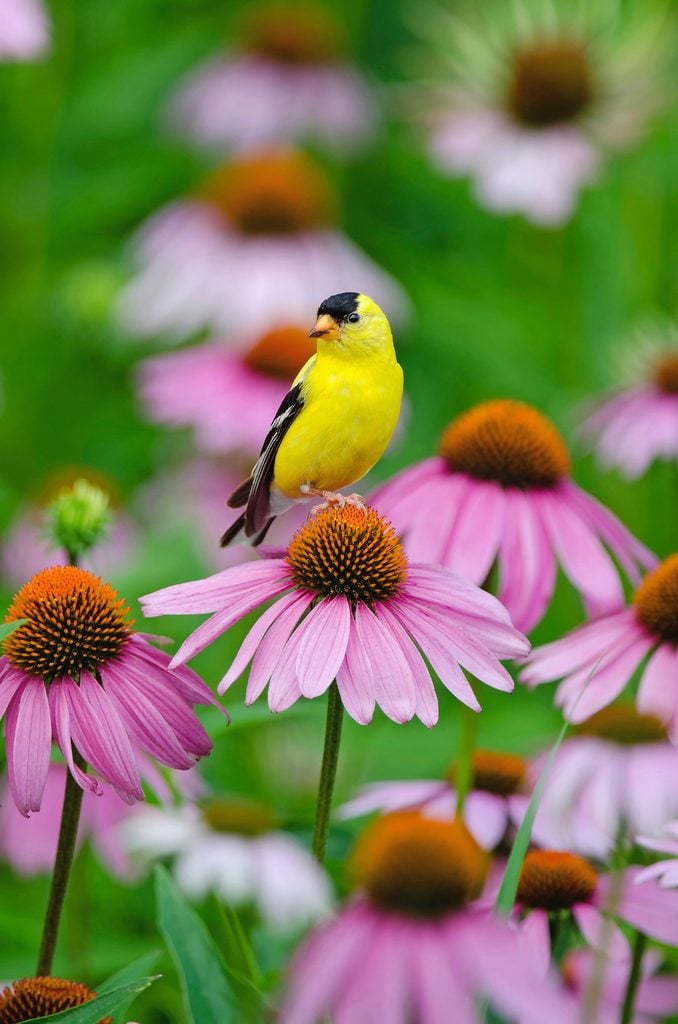
Their diet consists primarily of seeds, cracking them open with their short bills. Favorite seeds include Nyjer, thistle, black oil sunflower, alder and aster, among others. They also snack on buds, sap and the bark of young twigs. To attract them to your yard, plant native thistles or milkweed. While goldfinches sometimes eat from the ground, they’re adapted to pluck seeds from swaying flower heads and feeders. Goldfinches are especially drawn to the seeds of sunflowers, coneflowers, asters and grasses.
Attract goldfinches with nearly any type of feeder filled with sunflower seeds, Nyjer or millet. Try tube feeders with short perches to encourage goldfinches and to discourage house sparrows. Sock feeders also dispense tiny thistle seeds and are attractive to goldfinches, pine siskins and chickadees.
“We never had goldfinches visit until my family put out a thistle feeder. We had a pair within three hours. I love the pop of color they bring to my yard!” says Jessica Paoletti of New Castle, Delaware.
Plant a goldfinch garden with their favorite plants.
American Goldfinch Song
Listen for their four-syllable in-flight po-ta-to-chip call. Its other songs and calls are random series of warbles and twitters that last a few seconds, while its courtship call is a sharp tee-yee with a burst of sweet canary-like song that rises and falls.
Listen to the American goldfinch’s song.
Bird songs provided by the Cornell Lab of Ornithology.
American Goldfinch Habitat and Range Map
Goldfinches stay year-round in a large portion of the United States. As long as the minimum average temperatures stay above zero in winter, these birds tend to stick around.
Look for these birds in open areas including yards, fields, fencerows and groves. American goldfinches’ breeding range includes southern Canada all the way to northern Georgia and coastal California. In winter, they vacate the northern edge of this range, and flocks appear south to Florida and the Mexican border. Goldfinches aren’t under threat. Partners in Flight, a conservation organization, estimates a breeding population of 42 million. Found in cities and agricultural areas, “they are a species that has done well with human settlement,” Scott Gremel says.
These active birds have bouncy, aerobatic flight patterns. They pair off during breeding season, but other times of the year, they may fly in flocks of 50 to 100. “If you see a weedy field full of thistle, sometimes there will be a huge flock of goldfinches,” Scott says.
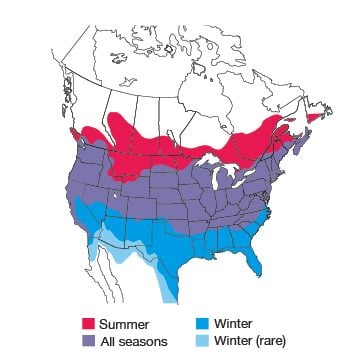
Range maps provided by Kaufman Field Guides, the official field guide of Birds & Blooms.
Next, learn how to tell the difference between a yellow warbler vs a goldfinch.
